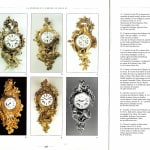
Pierre Kjellberg, “Encyclopédie de la Pendule Française du Moyen Age au XXe Siècle”, 1997, p. 100, pl. A, illustrating an extremely similar clock, signed on the dial Denis Masson à Paris, where reference is given to another similar clock with a movement by Ageron à Paris.
Charles Baltazar
Literature
Pierre Kjellberg, “Encyclopédie de la Pendule Française du Moyen Age au XXe Siècle”, 1997, p. 100, pl. A, illustrating an extremely similar clock, signed on the dial Denis Masson à Paris, where reference is given to another similar clock with a movement by Ageron à Paris.
Hans Ottomeyer and Peter Pröschel, “Vergoldete Bronzen”, 1986, p. 116, pl. 2.5.8, illustrating a clock with a movement by La Croix à Paris and case by Jean-Joseph de Saint-Germain, circa 1745, which is of comparable design but lacks the figure of Cupid below and has the dove at the summit.
An important Louis XV gilt bronze cartel clock of fourteen day duration, signed on the white enamel dial Charles Baltazar à Paris and Baltazar à Paris on the backplate, housed in a magnificent case attributed to Jean-Joseph de Saint-Germain. The white enamel dial with Roman and Arabic numerals and a very fine pair of pierced gilt brass hands for the hours and minutes. The movement with anchor escapement, spring driven silk thread suspension, striking on the hour and half hour on a single bell, with outside count wheel. The gilt bronze case of asymmetrical rocaille outline surmounted by a trellised cartouche mounted by a quiver of arrows above a dove amid abundant flowers and foliage that continue around the dial, with a glazed pendulum aperture beneath the dial and pierced sound frets to the side, with a recumbent Cupid below the dial entwined within foliate and floral scrolls
Paris, date circa 1745
Height 85 cm, width 38 cm.
One of the finest of its type and epitomising the beauty and delicacy of the Rococo, this clock case was most probably made by the eminent bronzier Jean-Joseph de Saint-Germain (1719-91). This attribution is strengthened by the fact that he was one of the main suppliers of cases to Henri-Charles Balthazar, who as here often signed his dials and movements Charles Baltazar. Henri-Charles Balthazar, also known Charles père l’Aîné was one of the most famous members of a large family of clockmakers and a leading Parisian maker during the Louis XV and early Louis XVI periods. The son of Henry, his brothers Antoine, Denis, Noël, Jean-Chrysostome and Joseph were also fine makers as was his own son, Louis-Charles (maître 1768). Having become a maître-horloger in 1717, Charles soon established great repute and gained the title of Horloger de Mesdames Filles de France. His impressive list of clients included the Garde-Meuble de la Couronne, as well as the Russian Ambassador, the comte d’Armentières, the marquis de Saint-Georges and Monsieur Castel. By 1733 he was established at Place Dauphine, four years later at the Cloister de Saint-Germain de l’Auxerrois. By 1747 he was working in rue du Roule where he continued until at least 1772 at which date he received the Freedom of the City. He made watches as well as cartels, mantel and longcase clocks. As fitting a clockmaker of his standing his cases were made by the finest makers of the day. In addition to Jean-Joseph de Saint-Germain gilt and patinated cases were made by Edme Roy, Jacques Dumont and Jean-Louis Beaucour. Balthazar Lieutaud, Jean Goyer and Antoine Foullet were among leading ébénistes to supply him and in turn Balthazar supplied movements to the ébénistes Jean-François Oeben and Jacques Dubois. Today one can admire his work in the Musée de Château de Champs and the Museum für Künsthandwerk in Dresden.
Like Balthazar, Jean-Joseph de Saint-Germain was a leader in his field who worked ouvrier-libre from 1742 and was received as a maître in 1748 and in 1765 he was elected a Juré of his guild. A fondeur of infinite skill, whose knowledge of the natural science was reflected in his art, Saint-Germain was also a champion of the Rococo style. Among his most celebrated case models is a cartel depicting Diana the Huntress and a mantel clock portraying The Rape of Europa (both Musée du Louvre), in addition to his equally famous pendules à l’éléphant and au rhinoceros. He later played an important role in the Neo-classical movement, casting for instance the Genius of Denmark clock of 1765 designed by A. Pajou for Frederick V of Denmark, now in the Amalienborg Palace, Copenhagen. Other examples from his oeuvre can be found in the Metropolitan Museum, New York; the J. P. Getty Museum, California; the Walters Art Gallery, Baltimore; Schloss Schleissheim in Munich and Schloss Charlottenburg in Berlin.


